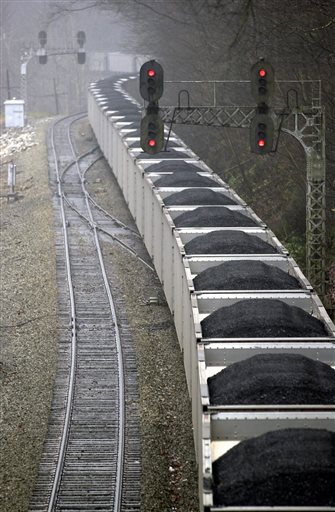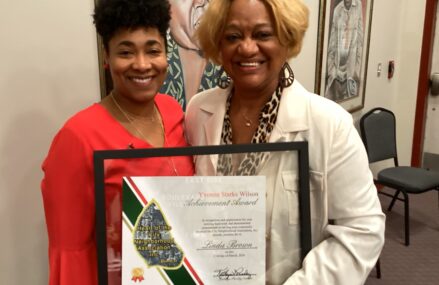
By BRUCE SCHREINER
FILE – A C.S.X. train loaded with coal winds its way into the mountains in this Nov. 21, 2004 file photo taken near the New River at Cotton Hill in Fayette County, W.Va. For decades, coal from West Virginia’s vast deposits was mined and hauled off without leaving behind the benefit of a lasting trust fund financed by the state’s best-known commodity. In 2013 a new bonanza in the natural gas fields has state leaders proposing to create an oil and natural gas trust fund for future generations. (AP Photo/Jeff Gentner)
CHARLESTON, W.Va. (AP) — For decades, coal from West Virginia’s vast deposits was mined, loaded on rail cars and hauled off without leaving behind a lasting trust fund financed by the state’s best-known commodity. Big coal’s days are waning, but now a new bonanza in the natural gas fields has state leaders working to ensure history doesn’t repeat itself.
West Virginia’s Senate president, Jeff Kessler, is pushing to create an oil and natural gas trust fund to support core government functions decades from now. His goal: a cushion of funds long after the gas is depleted to buoy an Appalachian mountain state chronically vexed by poverty, high joblessness, and cycles of boom and bust.
The Democratic Senate leader said the previous generation missed out on creating a permanent fund based on coal severance tax revenues. Current residents, he said, should be prudent and set aside a part of the revenue from the extraction of natural gas to benefit future generations.
“Had we had the good sense to put a few cents aside of every ton of coal … that has come out of our ground, we’d probably be the richest state in the Union instead of in many respects the poorest,” Kessler said.
Indeed, supporters say the future health and welfare of the state is, to some extent, at stake. West Virginia consistently has ranked among the states with the lowest life expectancy while grappling with problems of obesity, education and drug abuse.
“This is really about protecting the long-term fiscal health of the state,” said Ted Boettner, executive director of the West Virginia Center on Budget and Policy. “Without a plan for the future, we’re likely to continue to experience a lack of economic diversity, cycles of boom and bust and poor economic outcomes.”
Kessler’s isn’t a new concept. Other states with abundant natural resources have set up legacy funds as Alaska voters did in 1976 with a constitutional amendment creating the Alaska Permanent Fund to protect a portion of that state’s oil wealth for future generations. That vote came amid construction of the trans-Alaska pipeline and the fund is now worth billions.
Kessler is still crafting his Future Fund proposal for the 2014 legislative session that opens in January. He said he’s leaning toward presenting it as a proposed constitutional amendment. His call for a trust fund would go on next year’s ballot for voters to decide if it clears the Legislature.
His proposed endowment would be built with a portion of oil and natural gas severance tax collections. The trust could not be tapped for a specified number of years and would be limited to supporting a few needs including education, economic development or tax relief once it became accessible.
Kessler said constitutional protections would lock down the fund from lawmakers and interest groups tempted to pry it open prematurely to spend money elsewhere. “I don’t want it to be willy nilly, people using it for pet projects,” he said.
He notes that places such as Alaska are already benefiting handsomely from their funds.
Supported by about 30 percent of all mineral royalties the state receives, the Alaska Permanent Fund is invested in a broad portfolio and recently had an unaudited market value of $46.6 billion. Dividends, coming from investment profits, are paid each year to most Alaskans. Last year, the payment amounted to $878 per person. Principal can’t be spent.
Then there is North Dakota. Kessler recently led a group of West Virginia lawmakers there to study state’s legacy fund.
In 2010, North Dakota voters approved their Legacy Fund, which has been rising faster than predicted with booming oil production. Oil and gas revenue that began gushing in only since September 2011 had topped $1.3 billion as of last month. The fund gets 30 percent of the state’s oil and gas tax collections. None of the money can be spent until 2017, and only then if the Legislature decides by a two-thirds vote to dip into it.
Natural gas production in the big Marcellus Shale formation underlying parts of West Virginia and other nearby states has been rising even faster than energy experts had predicted. That production in West Virginia alone nearly doubled in the last five years and could nearly double again in coming years, they say.
Tapping it can require an unconventional horizontal drilling method as well as hydraulic fracturing. Also known as fracking, that process relies on water drawn from area sources that’s mixed with chemicals and sand and then pumped into wells to crack the rock.
As a result of the production boom, natural gas severance tax collections in West Virginia are expected to surge.
But despite the welcome news, some are taking a wait-and-see approach.
Corky DeMarco, executive director of the West Virginia Oil and Natural Gas Association, said the proposal to divert money into a fund that’s untouchable for years comes at a time of a shrinking state budget.
“In theory, I’m not sure how anyone could not support leaving something for their children and grandchildren,” he said. “The problem is that we are looking at budget deficits in West Virginia.”
The Legislature agreed in April to cut ongoing spending by $28 million and expects to face more budget pressures next year.
The oil and gas industry worries that talk of creating a permanent fund could veer onto another subject, such as tax rates, DeMarco said.
Kessler said his legislation would not increase severance tax rates.
Boettner estimates that an oil and gas trust fund started now could accumulate $2 billion to $4 billion by 2040, if it wasn’t tapped. But that wouldn’t be politically practical, he said, adding that the fund would probably need to be accessible within five to 10 years to build public support.
West Virginia House Speaker Tim Miley said some form of a Future Fund “carries great potential.” He and Kessler, along with the House and Senate Finance committee chairmen, plan to meet with other legislators who visited North Dakota as they prepare for next year’s session.
Getting a constitutional amendment on the ballot requires super-majority support in both legislative chambers, and Kessler said he thinks that is attainable.
“Rather than pouring it all into the General Revenue fund and spending every dime we get and wake up 20 years from now and say, ‘What did we do with all that money,’ we could say, ‘Hey, we put it in the bank and put some aside,” he said.
That could be welcome money for a state struggling on many fronts.
In July, the federal Centers for Disease Control and Prevention said West Virginia ranked among the worst four states for life expectancy and healthy life expectancy. In June, a report by the national KIDS COUNT project — backed by Annie E. Casey Foundation — found that 26 percent of West Virginia’s children live in poverty. The report also said West Virginia’s educational system ranks fourth-worst in the nation, citing in part a lack of quality pre-kindergarten programs.
And while West Virginia has been a coal-producing powerhouse for generations, Kessler noted, some of its most economically stressed areas are in the heart of the coalfields.
“When the (coal) seams got thinner and the jobs were done, there was just nothing to sustain their communities,” Kessler said. “I don’t want to see that happen again … when I see another golden opportunity where we have something in great supply and enormous demand.”
______
Associated Press writers Becky Bohrer in Juneau, Alaska, and James MacPherson in Bismarck, N.D., contributed to this report.


